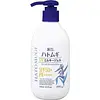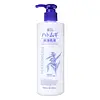What's inside
What's inside
 Key Ingredients
Key Ingredients

 Benefits
Benefits

 Concerns
Concerns

 Ingredients Side-by-side
Ingredients Side-by-side

Water
Skin ConditioningEthylhexyl Methoxycinnamate 9.5%
UV AbsorberAlcohol
AntimicrobialButyl Methoxydibenzoylmethane 1%
UV AbsorberOctocrylene 1%
UV AbsorberSteareth-6
EmulsifyingDimethicone
EmollientButylene Glycol
HumectantCarbomer
Emulsion StabilisingCoix Lacryma-Jobi Ma-Yuen Seed Extract
Skin ConditioningRosmarinus Officinalis Leaf Extract
AntimicrobialPrunus Persica Leaf Extract
EmollientAloe Barbadensis Leaf Extract
EmollientCitrus Junos Peel Oil
AstringentCocos Nucifera Oil
MaskingSodium Hyaluronate
HumectantCeramide Ng
Skin ConditioningXanthan Gum
EmulsifyingTetrasodium EDTA
Sodium Hydroxide 0.1%
BufferingBHT
AntioxidantMethylparaben 0.2%
PreservativeEthylparaben 0.01%
PreservativePhenoxyethanol 0.9%
PreservativeWater, Ethylhexyl Methoxycinnamate 9.5%, Alcohol, Butyl Methoxydibenzoylmethane 1%, Octocrylene 1%, Steareth-6, Dimethicone, Butylene Glycol, Carbomer, Coix Lacryma-Jobi Ma-Yuen Seed Extract, Rosmarinus Officinalis Leaf Extract, Prunus Persica Leaf Extract, Aloe Barbadensis Leaf Extract, Citrus Junos Peel Oil, Cocos Nucifera Oil, Sodium Hyaluronate, Ceramide Ng, Xanthan Gum, Tetrasodium EDTA, Sodium Hydroxide 0.1%, BHT, Methylparaben 0.2%, Ethylparaben 0.01%, Phenoxyethanol 0.9%
Water
Skin ConditioningGlycerin
HumectantParaffinum Liquidum
EmollientSqualane
EmollientButylene Glycol
HumectantPetrolatum
EmollientCoix Lacryma-Jobi Ma-Yuen Seed Extract
Skin ConditioningCeramide Ng
Skin ConditioningButyrospermum Parkii Butter
Skin ConditioningPrunus Persica Leaf Extract
EmollientBetaine
HumectantSodium Hyaluronate
HumectantSteareth-6
EmulsifyingSodium Hydroxide
BufferingCarbomer
Emulsion StabilisingTetrasodium EDTA
Methylparaben
PreservativeEthylparaben
PreservativeWater, Glycerin, Paraffinum Liquidum, Squalane, Butylene Glycol, Petrolatum, Coix Lacryma-Jobi Ma-Yuen Seed Extract, Ceramide Ng, Butyrospermum Parkii Butter, Prunus Persica Leaf Extract, Betaine, Sodium Hyaluronate, Steareth-6, Sodium Hydroxide, Carbomer, Tetrasodium EDTA, Methylparaben, Ethylparaben
 Reviews
Reviews

Ingredients Explained
These ingredients are found in both products.
Ingredients higher up in an ingredient list are typically present in a larger amount.
Butylene Glycol (or BG) is used within cosmetic products for a few different reasons:
Overall, Butylene Glycol is a safe and well-rounded ingredient that works well with other ingredients.
Though this ingredient works well with most skin types, some people with sensitive skin may experience a reaction such as allergic rashes, closed comedones, or itchiness.
Learn more about Butylene GlycolCarbomer is a polymer of acrylic acid. Its main role is to create a gel consistency.
A high amount of carbomer can cause pilling or balling up of products. Don't worry, most products contain 1% or less of carbomer.
Ceramide NG is a type of Ceramide. The NG stands for a sphinganine base.
Ceramides are intercellular lipids naturally found in our skin that bonds dead skin cells together to create a barrier. They are known for their ability to hold water and thus are a great ingredient for dry skin.
Ceramides are an important building block for our skin barrier. A stronger barrier helps the skin look more firm and hydrated. By bolstering the skin ceramides act as a barrier against irritating ingredients. This can help with inflammation as well.
If you would like to eat ceramides, sweet potatoes contain a small amount.
Read more about other common types of ceramides here:
Ceramide AP
Ceramide EOP
Ceramide NP
You might know this plant as Job's Tears or Chinese pearl barley. It is a grain native to Southeast Asia.
This ingredient has skin conditioning properties. Emerging studies show the grain to exhibit antioxidant and anti-inflammation properties as well. (With one study finding this ingredient to be effective at blocking melanin when skin is exposed to UV).
Job's tears is rich in nutrients, such as thiamine, riboflavin, niacin and ascorbic acid.
You can also find great antioxidants such as ferulic acid, caffeic acid.
To top if off, ceramides are also present in this grain.
Learn more about Coix Lacryma-Jobi Ma-Yuen Seed ExtractEthylparaben is a preservative, is a paraben, and is not reef safe.
Methylparaben is a preservative and is a paraben. It is used to prevent the growth of fungus, mold, and other harmful bacteria. Parabens are chemicals used as preservatives in both cosmetics and food.
Methylparaben can be synthetically created. It can also be found naturally in some fruits, such as blueberries.
Oftentimes, Methylparaben is combined with other parabens to help increase the shelf life.
The safety of Methylparaben is currently being studied. While ongoing studies are looking into the safety of parabens, the results have been very mixed. Some studies have not found Methylparaben to be harmful.
Learn more about MethylparabenPrunus Persica Leaf Extract comes from the leaves of the peach tree.
Peach leaves contain antioxidants such as ferulic acid.
As an emollient, peach leaves help soften and moisturize your skin. Emollients create a barrier on the skin to prevent moisture from escaping. This helps keep your skin hydrated.
Learn more about Prunus Persica Leaf ExtractSodium Hyaluronate is hyaluronic acid's salt form. It is commonly derived from the sodium salt of hyaluronic acid.
Like hyaluronic acid, it is great at holding water and acts as a humectant. This makes it a great skin hydrating ingredient.
Sodium Hyaluronate is naturally occurring in our bodies and is mostly found in eye fluid and joints.
These are some other common types of Hyaluronic Acid:
Learn more about Sodium HyaluronateSodium Hydroxide is also known as lye or caustic soda. It is used to adjust the pH of products; many ingredients require a specific pH to be effective.
In small amounts, sodium hydroxide is considered safe to use. However, large amounts may cause chemical burns due to its high alkaline.
Your skin has a natural pH and acid mantle. This acid mantle helps prevent harmful bacteria from breaking through. The acid mantle also helps keep your skin hydrated.
"Alkaline" refers to a high pH level. A low pH level would be considered acidic.
Learn more about Sodium HydroxideWe don't have a description for Steareth-6 yet.
Tetrasodium EDTA is the salt formed from neutralizing ethylenediamine tetraacetic acid with sodium hydroxide. It is a chelating agent and used to prevent metal ions from binding to other ingredients. This helps keep the product and ingredients stable.
Tetrasodium EDTA comes as a white solid and is soluble in water.
Water. It's the most common cosmetic ingredient of all. You'll usually see it at the top of ingredient lists, meaning that it makes up the largest part of the product.
So why is it so popular? Water most often acts as a solvent - this means that it helps dissolve other ingredients into the formulation.
You'll also recognize water as that liquid we all need to stay alive. If you see this, drink a glass of water. Stay hydrated!
Learn more about Water